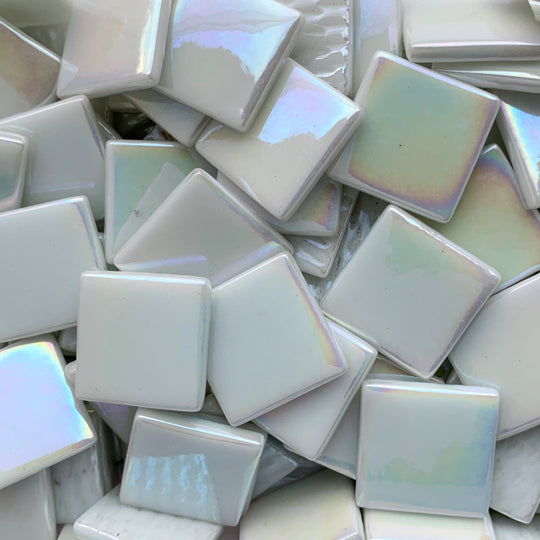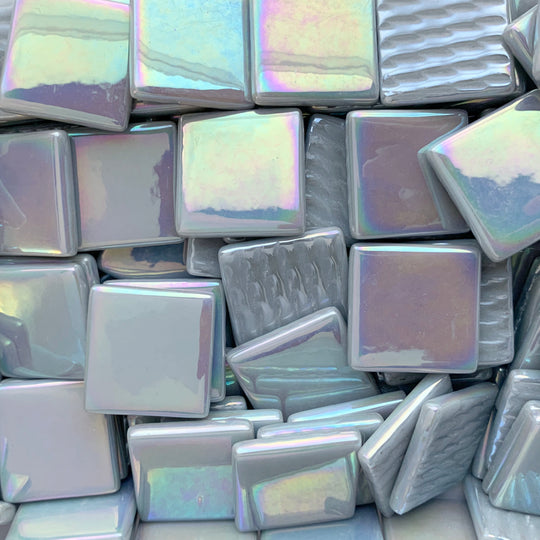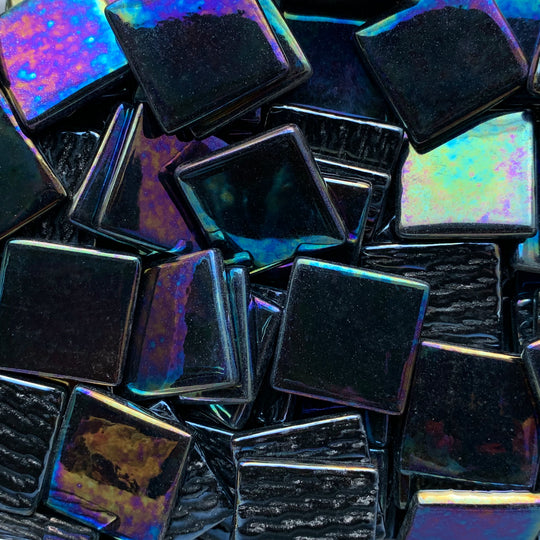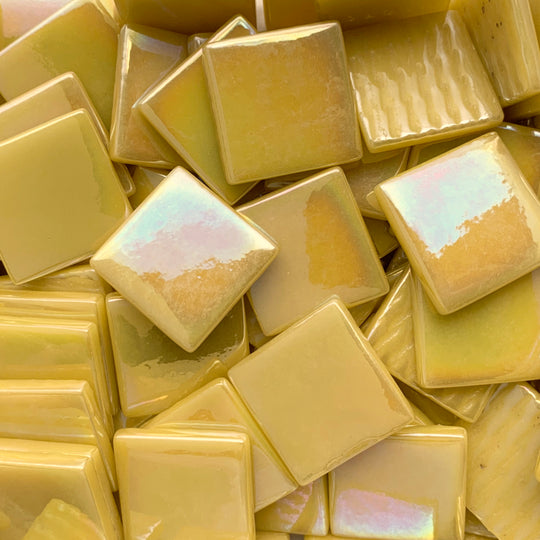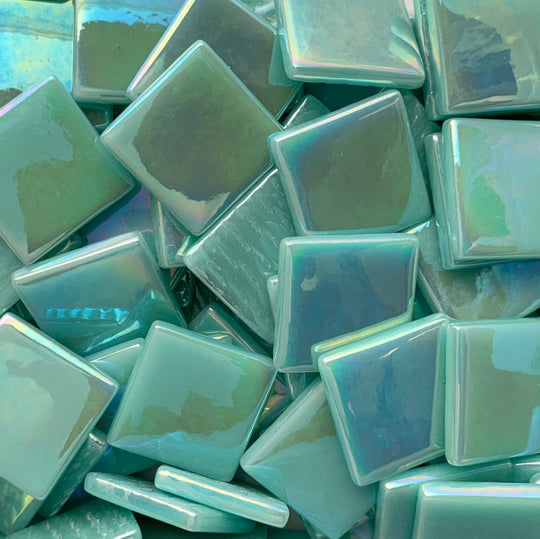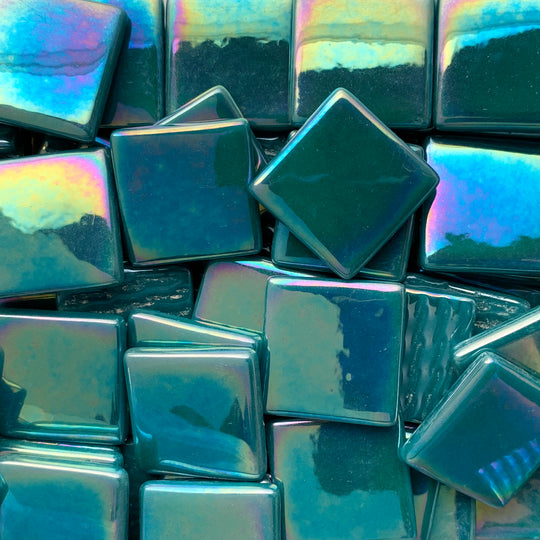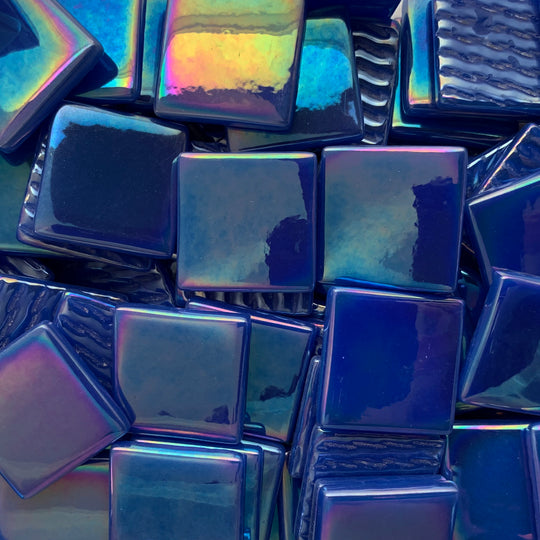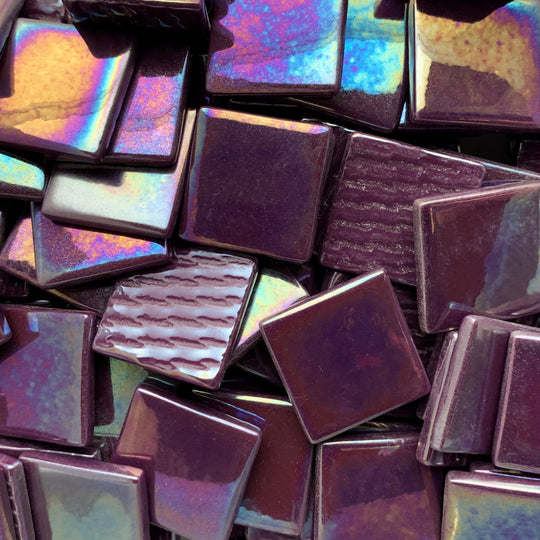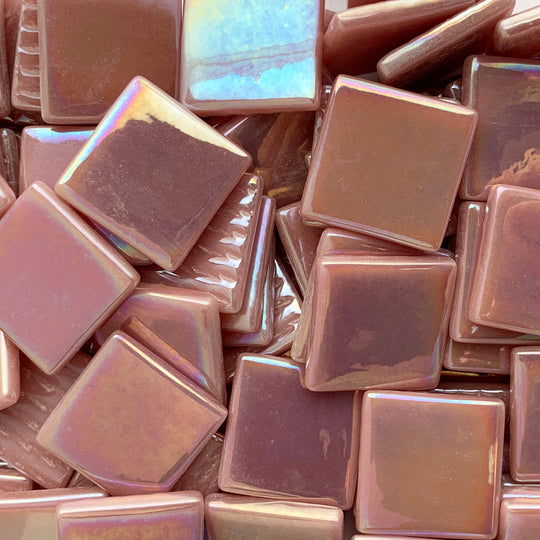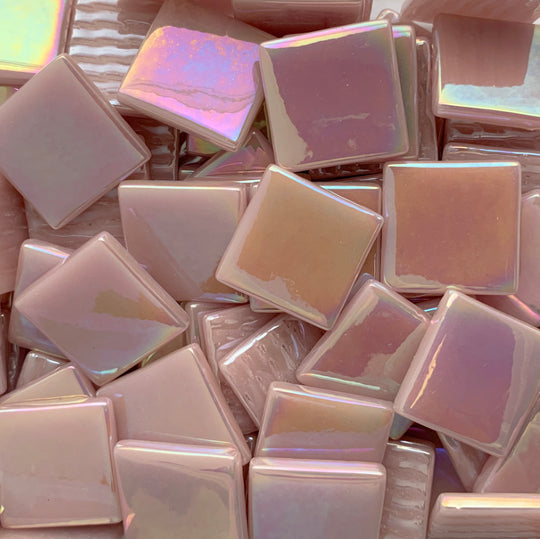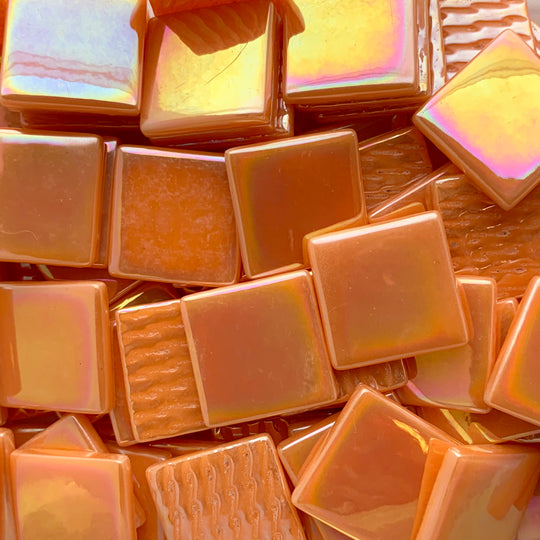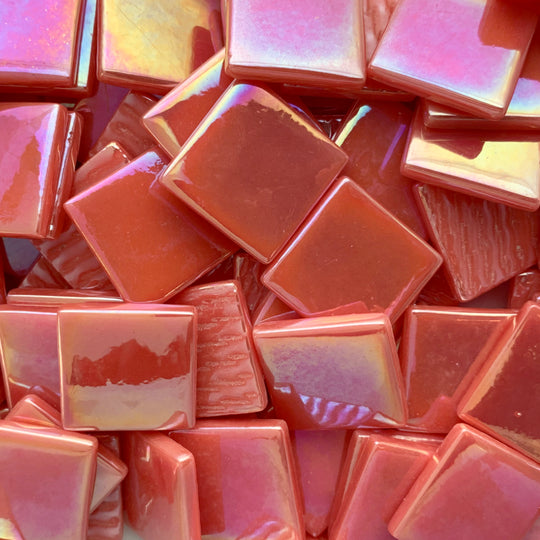Pâte de Verre Iridescent 25mm – Glass Mosaic with Rainbow Sheen
Discover the enchanting beauty of Pâte de Verre Iridescent, a unique 25mm glass mosaic tile with a fascinating rainbow sheen that changes color with every perspective. These premium tiles are made from 100% recycled glass and are colored with natural minerals and oxides. The characteristic iridescent finish is created by an advanced metal oxide coating, which not only provides a spectacular visual effect but also significantly increases scratch resistance and chemical resistance. UV and frost resistant, suitable for both indoors and outdoors – the perfect material for mosaic artists and architects seeking a dynamic, durable, and authentic product with a rich cultural history.
The Rich History of Pâte de Verre
The term Pâte de Verre, literally translated as 'glass paste', refers to a centuries-old and sophisticated glass art technique that originated in ancient Egypt and Mesopotamia around 3000 years ago. This historical method involved using finely ground glass powder, mixed with a binder and colorants, which was then packed into negative molds, fused in a kiln, and slowly cooled to minimize tension.
Although the modern 25mm mosaic tile is industrially manufactured, the name Pâte de Verre is retained as a tribute to this craftsmanship tradition. This creates a direct cultural and historical association, linking the contemporary product with centuries-old artistry. Mosaic art itself dates back even further – to 3000 BC in Mesopotamia and Egypt, where small colored stones and shells were used to create decorative patterns.
The modern Pâte de Verre tiles are often associated with Ottoman splendor and the famous Turkish tile traditions. This cultural positioning connects the product with the exclusivity of centuries-old craftsmanship, with large manufacturers of recycled glass tiles often located in Turkey, such as Istanbul, establishing a direct geographical link between modern sustainable production and high-quality artistic tradition.
What Makes Iridescent Pâte de Verre Unique?
The Fascinating Iridescent Effect
The most striking feature of these tiles is their iridescent finish – an optical phenomenon where the color changes depending on the viewing angle and the angle of incidence of light, creating a dynamic, rainbow-like effect. This is achieved by an advanced metal film coating of extremely thin layers of metal oxides (such as titanium or silicon) applied in the order of nanometers.
This coating is not merely cosmetic – it has direct functional benefits. The metal oxides form a robust barrier that reduces the inherent fragility of glass and significantly increases scratch resistance and chemical resistance. This makes the tiles extremely suitable for chemically stressed environments such as swimming pools, showers, and outdoor applications.
100% Recycled Glass with Natural Coloring
The Pâte de Verre tiles are produced from 100% recycled glass, which is an important ethical and ecological choice. The recycled glass is colored with natural minerals and oxides to achieve the desired hues and color stability, combining the historical method with contemporary sustainability requirements.
Technical Specifications and Production
Dimensions and Weight
- Tile Format: 25x25mm (1 inch) – ideal balance between detail and quick coverage
- Thickness: 4mm (1/8 inch nominal)
- Weight: 100g contains approximately 18 tiles, covering an area of about 11x11cm
- Coverage per m²: 6 to 8kg of material needed
- COE (Coefficient of Thermal Expansion): 84-87, crucial for glass fusion projects
Material Composition
The tiles are made from opaque glass, which prevents the underlying adhesive or substrate from showing through the glass – a common aesthetic problem with fully transparent glass mosaic. Nevertheless, the iridescent finish creates an optical depth and shine that enlivens the surface.
The Production Process
Modern production combines sustainability with advanced technology. The industrial process involves guiding small, shaped glass pieces through a linear kiln. After fusion at high temperatures, the tiles undergo a controlled annealing process (slow, controlled cooling) to relieve internal stresses and stabilize the glass.
Production Steps:
- Recycling: collection and cleaning of recycled glass
- Coloring: addition of natural minerals and oxides
- Fusion: heating in a linear kiln to liquid glass
- Annealing: controlled cooling for stability
- Coating: application of metal oxide layers for iridescence
- Quality Control: inspection of each tile
This results in mosaics that are among the strongest and most durable on the market, with production hubs often located in Istanbul, Turkey.
Exceptional Properties
UV and Frost Resistant
The tiles are designed with extreme environmental conditions in mind. They are explicitly UV and frost resistant, guaranteeing that the colors remain stable under intense sunlight and that structural integrity is maintained at freezing temperatures. This makes them suitable for all climates and both indoor and outdoor use.
High Chemical Resistance
The metal oxide coating not only enhances visual appeal but also offers superior chemical resistance. This makes the tiles ideal for swimming pools, spas, shower areas, and other chemically stressed environments where resistance to chlorine, cleaning agents, and other chemicals is essential.
Increased Scratch Resistance
The robust metal oxide layers form a protective barrier that significantly increases scratch resistance compared to traditional glass. This reduces long-term maintenance risks and increases attractiveness for high-traffic commercial applications.
Ribbed Back for Optimal Adhesion
A crucial technical detail is the slightly ribbed back. These ribs serve as mechanical keying and significantly improve the adhesion strength between the tile and the adhesive. The profile ensures that the adhesive can firmly set around the protrusions, which is essential for durable installation.
Working with Pâte de Verre Iridescent
Cutting and Processing
Despite the robust durability, the tiles are easy to work with. The most recommended tool is a glass cutter or nipper, which can cut the tiles with minimal waste. This makes complex patterns accessible to both professionals and DIY enthusiasts.
Recommended Tools:
- Glass nippers for precise cuts
- Safety goggles (mandatory)
- Cutting mat or protective base
Installation: The Crucial Choice of Adhesive
The installation of Pâte de Verre requires specific attention to the choice of adhesive. Due to the 4mm thickness and the ribbed back, the adhesive choice is the most critical factor for long-term success.
For Interior Use
- White Wood Glue (PVA): dries transparent, ideal for decorative panels
- Ready-mixed Paste Adhesive: user-friendly, strong adhesion
- Silicone Adhesive: for 3D objects and curved surfaces
Important: Flexible Adhesive for Outdoor and Wet Areas
For outdoor projects, underfloor heating, and wet areas, a frost-resistant, flexible powder adhesive (Polymer-modified, C2TES1 or S2 classification) is essential. A rigid adhesive cannot absorb the tensions caused by temperature changes, which leads to cracking or detachment. For exterior applications, the adhesive must be pressed completely into the ribs to prevent air pockets – trapped moisture can freeze and expand, which can damage the tile.
Adhesive Selection by Application
- Dry Interiors: paste adhesive, wood glue, or silicone adhesive
- Wet Interiors: flexible powder adhesive (C2TE), white, moisture-resistant
- Exterior Facades and Patios: highly flexible powder adhesive (C2TES1/S2), white, frost-resistant
- Floors with Heating: very flexible powder adhesive (S1/S2), high adhesion strength
Grout and Finishing
The adhesive and the grout must be chemically compatible. For glass mosaic in wet and chemically stressed environments, epoxy grout is often preferred, which offers superior chemical resistance and waterproofing. Choose the color of the grout carefully to ensure coordination with the adhesive and tile color.
Professional Tip: Apply the adhesive completely into the ribs on the back to prevent air pockets. This is crucial for exterior applications – trapped moisture can freeze and cause the tile to detach. Always test on a small area first to check compatibility.
Maintenance and Care
The Pâte de Verre tiles benefit from the built-in durability of the metal oxide coating, resulting in minimal maintenance requirements. The chemical resistance and scratch resistance make the tiles easier to care for than traditional glass.
Recommended Maintenance:
- Clean with pH-neutral soap and water
- Avoid aggressive abrasive cleaners or strong acids
- For stubborn stains: mild solvents
- Dry with a soft, non-linting cloth
The inherent chemical resistance of the coating reduces long-term maintenance risks and increases attractiveness for commercial applications.
Applications and Design Possibilities
The technical specifications and the unique iridescent effect make Pâte de Verre universally applicable for various projects:
Interior Use
- Bathrooms: walls, shower enclosures, floors
- Kitchens: backsplashes, countertops, decorative accents
- Swimming Pools and Spas: resistant to chlorine and chemicals
- Living Areas: wall decorations, art objects
- Commercial Spaces: hotels, restaurants, shops
Exterior Use
- Facades: architectural accents with light reflection
- Patios and Terraces: frost-resistant and UV-stable
- Garden Art: fountains, sculptures, decorative panels
- Public Spaces: museums, theaters, commercial centers
Design Flexibility: Light as the Primary Parameter
The iridescent finish transforms the tile from a static material into a dynamic, light-dependent medium. The color shifts shimmer in the sunlight and offer a constantly changing visual experience. When designing, the incidence of light – both natural and artificial – should be the primary design parameter.
Design Tip: The iridescent effect is most spectacular when subtly incorporated into the whole. Use Pâte de Verre as an accent in combination with neutral tiles for maximum impact, or create complete surfaces for a breathtaking, color-shifting experience. The opacity makes the tiles ideal for wall decoration, and they can be effectively combined with transparent or opal mosaic stones for projects with light transmission.
Sustainability and Environmental Awareness
Pâte de Verre tiles embody a sustainable production ethic that aligns with the contemporary demand for ecologically responsible materials:
- 100% recycled glass: reduces the need for primary raw materials
- Energy savings: recycling saves energy during the melting process
- Natural colorants: minerals and oxides instead of synthetic chemicals
- Long lifespan: decades of use due to robustness and UV resistance
- Fully recyclable: can be re-melted without loss of quality
- Minimal maintenance: no special cleaning agents required
These sustainability features make Pâte de Verre a premium ecological choice for conscious consumers and projects with LEED or BREEAM certification.
Frequently Asked Questions
What is the difference between Pâte de Verre and regular glass mosaic?
Pâte de Verre refers to a specific production technique with historical roots and is made from 100% recycled glass. The main difference is the iridescent coating – an advanced metal oxide layer that not only provides a spectacular color-shifting effect but also increases scratch resistance and chemical resistance. Standard glass mosaic does not have an iridescent finish and lacks this extra protective layer.
Can I use Pâte de Verre in my swimming pool?
Absolutely! Pâte de Verre is excellently suited for swimming pools. The metal oxide coating offers superior chemical resistance to chlorine, salt, and other pool chemicals. The tiles are also waterproof, UV-resistant, and frost-resistant. However, use an appropriate flexible, moisture-resistant adhesive (C2TE) and epoxy grout for optimal durability.
Are the tiles suitable for underfloor heating?
Yes, Pâte de Verre is compatible with underfloor heating, provided it is correctly installed with a very flexible powder adhesive (S1/S2 classification). This adhesive absorbs the thermal expansion and contraction caused by the heating cycle. Note: turn off the underfloor heating during post-installation cleaning.
Does the iridescent finish fade in the sun?
No, the tiles are UV-resistant. The metal oxide layers that create the iridescent effect are intrinsically stable and resistant to intense sunlight. The colors and optical effect remain intact, even after years of direct sun exposure, making them ideal for exterior facades, patios, and garden projects.
How should I handle the ribbed back during installation?
The ribbed back requires the adhesive to be pressed completely into the ribs to prevent air pockets. This is crucial for exterior applications – trapped moisture in the ribs can freeze and expand, leading to tile detachment. Use a notched trowel to apply the adhesive evenly and press the tile firmly.
What color grout should I use?
The color of the grout is an important design choice. For a subtle effect that allows the iridescent glass to sparkle, choose a neutral color such as white, light gray, or beige. For a more dramatic effect, choose a contrasting color. Always test on a small area first. For wet rooms and swimming pools, use epoxy grout for superior waterproofing.
How much extra material should I order?
Count on an allowance of 10-15% extra material to accommodate cutting waste and possible damage. The amount of waste depends on your pattern (straight or diagonal installation) and the complexity of the design. Up to 20% extra may be required for very complex patterns.
Can I combine Pâte de Verre with other materials?
Certainly! Pâte de Verre combines beautifully with natural stone, ceramic tiles, standard glass mosaic, smalti, and gold glass. The iridescent effect is particularly striking as an accent next to matte or neutral materials. Note that all materials must have similar COE values if you are applying glass fusion.
Are the tiles slippery on wet floors?
The smooth, iridescent surface can be slippery when wet, especially in showers or around swimming pools. For floor applications in wet environments, we recommend: (1) applying an anti-slip treatment, (2) combining with matte glazed tiles with a non-slip surface, or (3) only using for wall decoration in wet areas.
What does the COE value of 84-87 mean?
COE stands for Coefficient of Thermal Expansion and indicates how much the glass expands and contracts with temperature changes. In glass fusion, it is crucial that all types of glass used have similar COE values to prevent cracking. The COE 84-87 of Pâte de Verre is compatible with many common glass fusion materials.
Can I use these tiles for a window decoration project?
Pâte de Verre is opaque glass, so it does not allow light to pass through. For window decoration or lamps where light transmission is desired, you should use transparent or opal mosaic stones, or combine Pâte de Verre with transparent glass for a mixed effect with iridescent accents.
Ready to Start?
Pâte de Verre Iridescent 25mm is more than a mosaic tile – it is a living, light-dependent work of art that transforms with every moment of the day. Whether you are a professional mosaic artist or an enthusiastic DIYer, these premium tiles with their rich history, sustainable production, and enchanting rainbow sheen offer endless creative possibilities. Each tile carries the heritage of 3000 years of glass art, combining it with modern sustainability and advanced technology. Be inspired by the Ottoman splendor and create your own masterpiece with Pâte de Verre – where history, art, and sustainability come together in a rainbow sheen.

